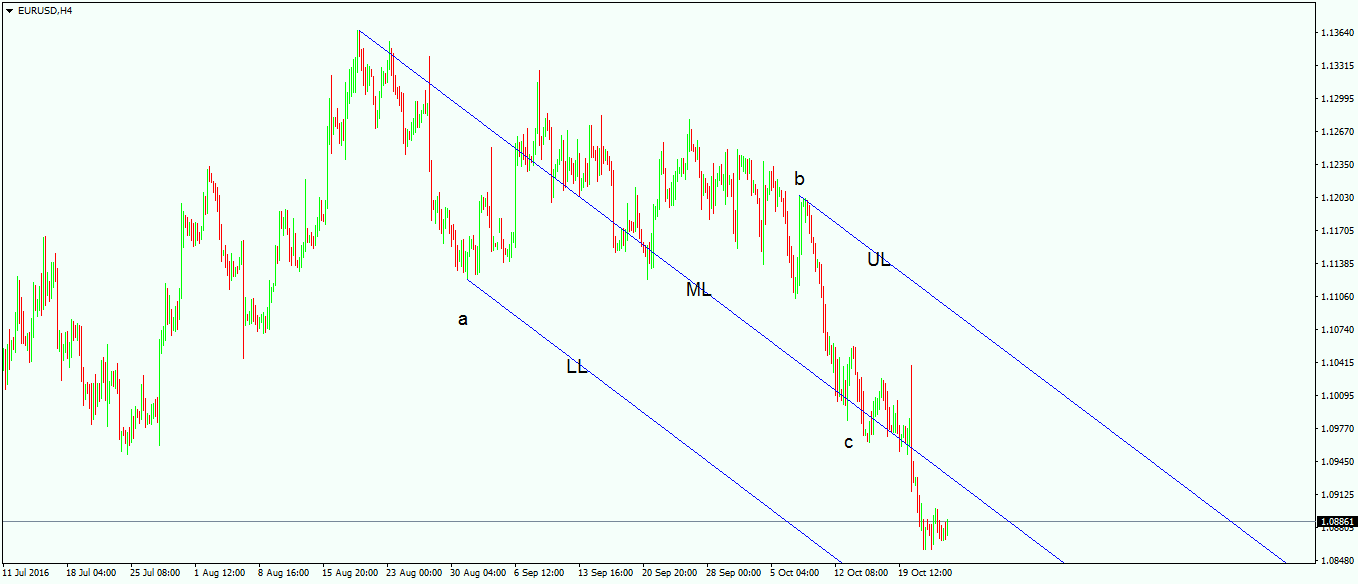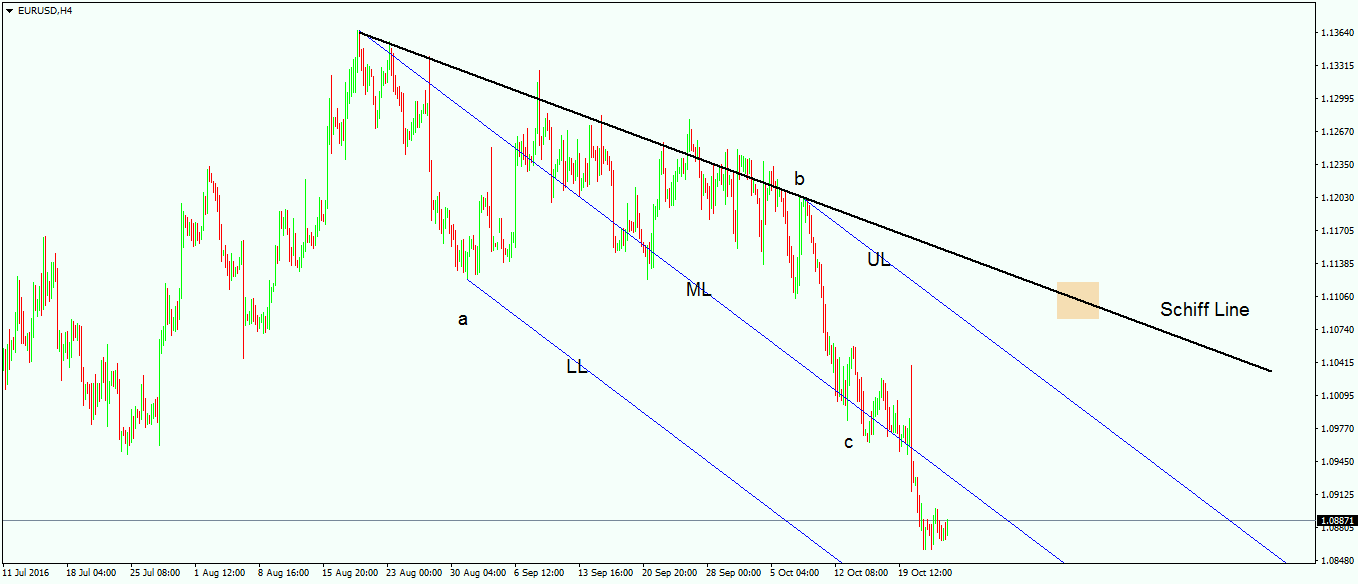Use Andrew’s Pitchfork in Forex
Andrew’s Pitchfork comes from the name of one Dr Andrew, who used a pitchfork to forecast future prices, and developed a trading system many find very interesting. The system became so popular over time that the Andrew’s Pitchfork trading tool has been integrated into all trading platforms. The idea behind trading with Andrew’s Pitchfork is to find three points, called pivots; and from those three pivots, the pitchfork should be drawn. Any pitchfork has three lines, and each line starts from the three pivots mentioned above. The lines are called the upper line (UL), the lower line (LL) and the median line (ML). Out of these three lines, the most important one is the ML, the reason being that it has an important characteristic: It attracts price. There are many ways to use the Andrew’s Pitchfork, and this is because it is a matter of controversy as to how to set the three pivot points. This is the most important decision when trading with a pitchfork, as different pivot points will result in different angles for the overall pitchfork, which will then lead to different results when interpreting the market.
| Broker | Bonus | More |
|---|
Trading with the Pitchfork
To overcome this inconvenience, traders use the Andrew’s Pitchfork tool in conjunction with the Elliott Waves theory. The reason for this is that the Elliott Waves theory allows for knowing exactly where a specific wave ends, and these endings are the places for the pivots to be set on the pitchfork.
Using the Pitchfork in Conjunction with Elliott Waves Theory
Because the Elliott Waves theory is based on both impulsive and corrective waves, there are two separate ways to use the pitchfork, both of which reflect the same thing: the fact that the price was attracted by the ML. A pitchfork comes in handy for finding the ends of specific waves under the Elliott Waves theory as well. This is very important for traders who count waves, as if the extension in an impulsive wave is respected, by the time the ML is reached, most likely the third wave in an impulsive move is completed as well.
Pitchfork with Impulsive Waves
The way to use the pitchfork tool with impulsive waves is to try to find the end of the third wave, as this is the most likely wave to extend. The three pivot points should therefore be placed as follows:
- The first pivot should be placed at the start of the impulsive wave. This would be the equivalent of the first click on the screen after selecting the Andrew’s Pitchfork tool.
- The second one should be the end of the first wave.
- The last one should be the end of the third wave.
The resulting pitchfork will resemble a rising channel in a bullish impulsive move, or a falling one in a bearish move. The distance between the ML and the other two lines in the pitchfork is always the same, as the ML stays at 50% distance. It means that the channel is basically split into two equal parts. In an impulsive wave, no matter whether a bullish or a bearish one, it is very difficult for the price to go much further than the ML. This is because in a bullish pitchfork, the price will rarely reach the UL, but will settle for the ML. By the time the ML is reached, look for the third wave in the impulsive wave to be completed, providing the extension rules are respected.
Pitchfork with Corrective Waves
The same thing is valid when it comes to corrective waves under the Elliott Waves theory, with the difference that the three pivot points that make up the Andrew’s Pitchfork are placed as follows:
- The first one at the start of the correction;
- The second one at the end of the a-wave;
- The third one at the end of the b-wave.
If, in the case of an impulsive move, the aim was to have an idea about the end of the possible third wave by the time it reached the ML, in this case the ML is used to find out the end of the c-wave. The c-wave can be the c-wave of a flat, a zigzag, or even a triangle. The idea is that its interpretation with the pitchfork is the same and, believe it or not, is very accurate, providing the Elliott Waves counting was correct.
Using Andrew’s Pitchfork to Spot Reversals
This way of using the pitchfork is the living proof that a trend has ended. Traders are now using a new line in conjunction with the three lines of the original pitchfork. Obtaining such a line is simple and straightforward, in the sense that all one needs to do is to connect the start of the pitchfork (or the first pivot) with the end of the pitchfork (or the last pivot). The resulting line is called the Schiff line, and it represents the bull/bear line that defines a trend. As a rule of thumb, the Schiff line should not be broken if the trend is still in place. If the Schiff line is broken by future price action, this will invalidate the pitchfork, which means that the trend described by the pitchfork is completed, and a new one started. If a new trend has started, then the previous pitchfork needs to be deleted, together with its Schiff line, and a new one for the new trend should be drawn. The big advantage when using the Schiff line is that the reversal is visible, and it is not possible to be caught on the wrong side of the market. The breaking of the Schiff line is lagging, and the market will most of the time move violently to break it. However, this doesn’t change the fact that traders are warned that the previous trend is over, and that they should reconsider the analysis. Such a break will have bearish implications in a bullish trend, and bullish implications in a bearish one.
There are other ways to use the Pitchfork. Some trading platforms use Fibonacci ratios to draw parallel lines with the ML and the UL and LL. These parallel lines are drawn at 61.8%, 161.8% or other Fibonacci ratios to find out future dynamic support and resistance levels.
Other educational materials
- The Importance of Press Conferences
- Forex Trading When Central Bankers Hold Speeches
- Risk-off vs. Risk-on Trading
- Forex Market Terminology
- Profit from Forex Trading Using Different Trading Styles
- How to Trade with Gartley
Recommended further readings
- Five point pattern. Peterson, D.D., Barrie Hetirachi’s
- “Cloud based Financial Market Prediction through Genetic Algorithms: A Review.” Soni, Nitasha, and Tapas Kumar. International Journal of Computer Applications 123, no. 8 (2015).




